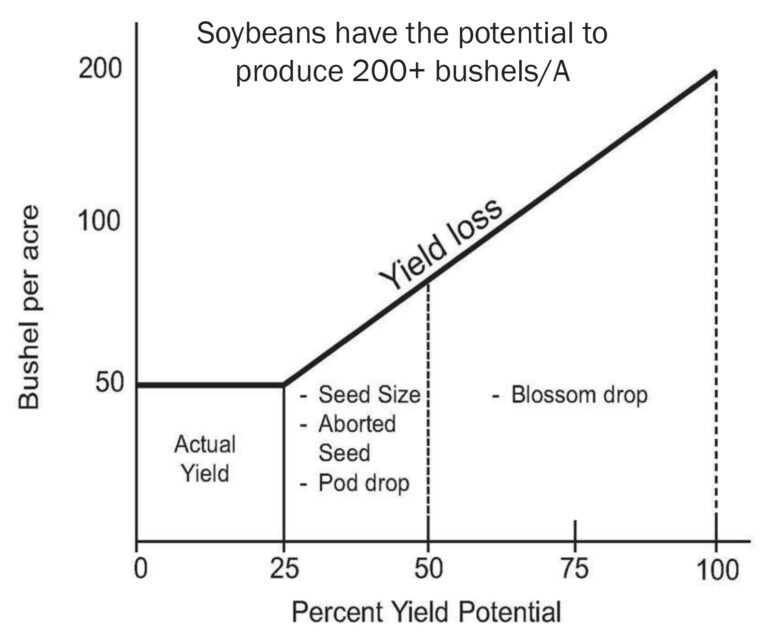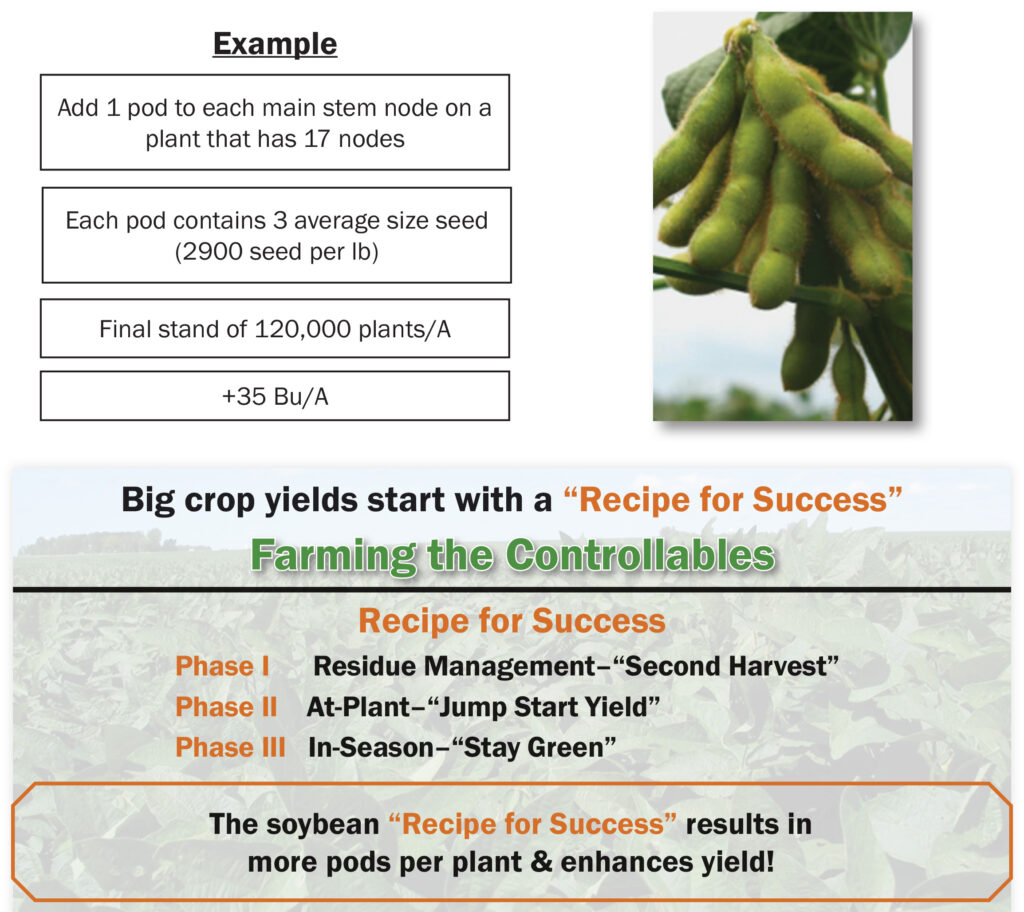Think like a Soybean Plant
Want to Grow Better Beans? 5 Tips to Think Like a Soybean Plant
If crops were pro football players, corn would be the all-pro quarterback, while soybeans would be the benchwarmers. Admit it—corn often receives all the glory, and a lot of farmers tend to treat soybeans as an afterthought. It doesn’t have to be that way, especially if you want to grow better beans.
“You need to ‘think like a soybean plant,’” said Dr. Jim Ladlie, founder and owner of ProfitProAG. “While it’s tempting to think you’re in control in production agriculture, I encourage you to take a more sustainable approach, understand more about plant and soil biology, and stay seven to 10 days ahead of your crop’s needs.”
If you understand how soybean plants grow and what they need for growth, you can do a better job of providing resources within your control to keep your crop productive. Here are five ways to make that happen:
1. Reduce tillage as much as possible. What’s the limiting nutrient in crop production? It’s carbon, which comprises 45% of the plant and provides the energy that powers plant growth and development, Ladlie said. Healthy soils filled with beneficial microbes and earthworms are rich in bio-active carbon, which is essential to plant health, growth and development. The beneficial microbes in a healthy soil produce enzymes that make nutrients readily available for plant uptake. “The microbes feed the plants, and the plants feed the microbes,” Ladlie said. Too much tillage, however, disrupts the environment where so many beneficial microbes reside. “Try to reduce tillage as much as possible, if you want to create healthier soils that nurture the microbes that help grow healthier, more resilient crops,” Ladlie said. “This can also help you reduce the need for insecticides, fungicides and other pesticides.”
2. Put beneficial microbes to work for you. When you help more beneficial microbes thrive in your soil, they’ll help protect your soybeans from insect pests and plant pathogens. Both types of biological control have been reported from the beneficial fungus Beauveria bassiana. “While this fungus lives in the soil, it’s not common in our Midwestern soils,” said Dennis Klockenga, a crops specialist with ProfitProAG. That’s why ProfitProAG includes Beauveria bassiana in its seed coatings, along with multiple strains of mycorrhizal fungi and other beneficial microbes, plus a blend of minerals and nutrients that feed the microbes. “Beauveria bassiana is especially important in conjunction with mycorrhizal fungi, which are vital for making phosphate in the soil readily available to crops,” Klockenga said. ProfitProAG’s seed coatings are available in liquid and dry and can be applied on-farm. “Our seed coatings help produce a more robust root system with larger roots and more root hairs, which contribute to an overall healthier plant,” Klockenga added.
3. Focus on foliar feeding. Feeding your crop at key times throughout its growing cycle helps keep plants healthy through the end of the growing season. That’s where foliar feeding comes in, starting at V4 to V6, Klockenga said. “The foliar-applied nutrients will hit the leaves and will also help feed the soil biology. This will keep the soybean plants healthy and going strong into the reproductive stage when the soybean plants flower.”
Did you know that soybean plants naturally lose 60% to 75% of their flowers? While no one knows for sure why they abort so many flowers, it’s clear that aborted flowers don’t grow into pods that produce soybeans. “What if your plants could hold onto more of those flowers—even 10% more?” Klockenga said. “You want to set the stage for this higher yield potential before the plants flower, and at flowering. Timely foliar feeding at R1 and R3 can help.”
4. Don’t skip the sulfur. While sulfur is a vital nutrient for photosynthesis, it’s sometimes in short supply in fields today. “Adequate sulfur is critical for soybeans, because it helps the plants produce protein and four amino acids,” Klockenga said. Signs of a sulfur-deficient crop include light-colored leaves, especially on young soybean leaves, Options for adding sulfur, as needed, include pre-plant or at-plant with ammonium sulfate (the dry form of sulfur). Elemental sulfur can also be used and is best applied in the fall.
5. Measure Brix. What if there were a “vitality score” that could help you assess your crop’s health during the growing season? There is, when you measure Brix levels, which reflect the quality of your crop, from nutrient density to flavor. Brix levels are measured on a scale from 0 (poorest) to 32 (best). Your goal is to produce crops with a Brix measurement of 12 or higher. “Anything below eight is not worthy of reproducing or eating,” Ladlie said. “In fact, it’s nature’s garbage. Unfortunately, many of the crops we test, including corn, soybeans and forage, have Brix levels of four to six” It’s easy to measure Brix levels right in the field with a simple, affordable tool called a refractometer (available at ProfitProAG along with a plant sap press). While a refractometer looks like a small flashlight, it’s a precision instrument that allows you to quickly measure the percentage of dissolved sugars in plant sap, Ladlie said. These sugar levels are correlated with the plant’s food-producing efficiency (photosynthesis) and the nutrition contained in the plant, including protein, mineral content and more.
Try the “Recipe for Success”
So how do you put all this together to “think like a soybean plant” and boost your crop’s yield and profit potential? That’s where ProfitProAG’s “Recipe for Success” comes in.
“Our “Recipe for Success” isn’t a cookie-cutter plan,” Ladlie said. “Each “Recipe for Success” is tailored to your acres, whether you raise soybeans, corn, small grains, forages or cover crops.”
The “Recipe for Success” includes three phases to help control the controllables:
- Phase I Residue Management. This “second harvest” focused on efficient breakdown of crop residue to improve soil health and boost nutrient retention/availability, nitrogen fixation, water infiltration, and carbon release to feed the crop during the growing season, while reducing residual insect and disease pressure. The key benefit is improved nutrient cycling from the crop residue, which can help lower your fertilizer bill.
- Phase II At-Plant. Jump start your yield, and get your crop off to a strong start with early-season plant health and vigor. Biological seed coatings and the right starter package supply key nutrients to seedlings and enhance plant health all season-long. Establishing healthy plants below and above ground is critical to maximizing the crop’s genetic yield potential. ProfitProAG’s seed coatings use biology, rather than chemicals, to help control crop disease and insect pests. “Many seed coatings use neonicotinoids to control insect pests, but a Purdue University study reported honeybee deaths linked to exposure to this seed insecticide,” Klockenga said. “Our seed coating helps fend off wireworms, grubs and other insect pests, but it doesn’t pose the potential safety issues that neonicotinoids can.” Also, the fungicide package on ProfitProAG’s seed coatings helps fend off Rhizoctonia, Pythium and Phytophthora rot, but it does it through competitive exclusion. “This means it helps create an environment where the plant can better fight off pathogens,” Klockenga said.
- Phase III In-Season. Stay green to the finish! This phase helps mitigate plant stress, which is critical when the reproductive phase of yield development begins. Foliar application of nutrients, energy and stress-reducing technology builds resilience and uniformity in a crop-production system. The end result is increased seed numbers, weight and nutrient density in grains. Forages show improved nutrient content, energy, taste, storability and reduced mycotoxins.
The ProfitProAG team is here to work with you every step of the way during the growing season and beyond. “When you use the “Recipe for Success” to ‘think like a soybean plant,’ you will build greater resilience, sustainability, consistency and profitability into your farming operation,” Ladlie said. “We can help provide the building blocks to help you grow higher-yielding, better-quality crops.”
To learn more about the “Recipe for Success,” controlling the controllables and boosting your farm’s profit potential, contact us. We look forward to hearing from you.
Click here for the print friendly version

How much did your soybeans yield last fall? Were you anywhere close to 88 bushels per acre? John Zittel achieves those kinds of yields. In fact, he’s won the New York Soybean Association’s yield contest for two years in a row. What are his secrets to successful soybean production? Hint: he’s not a fan of stressing his crops with AMS, but he is a fan of foliar feeding. See which of his proven, practical solutions might work on your farm.
Cause of Yield Loss in Soybeans
The leading cause of yield loss is a result of inadequate nutrient balance and availability, plus lack of energy–resulting in premature death.


